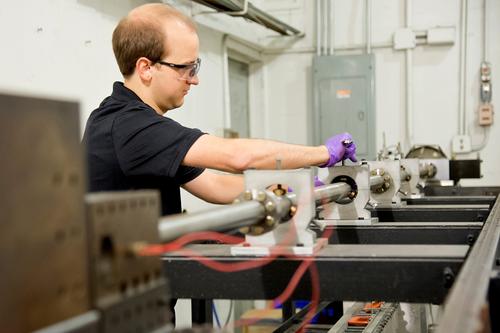Shock-Wave Energy Inspiration for Development of Super-Strong Materials
September 17, 2013

How do you create new materials stronger than anything that exists today? Create shock conditions similar to a meteorite striking the Earth, exert them on the material, and see what happens.
At least that's the theory behind research at the Center for Shock Wave-processing of Advanced Reactive Materials (C-SWARM), a center comprised of scientists from Purdue University, the University of Notre Dame, and Indiana University.
The center's primary focus is to predict shock conditions that can spawn the synthesis of new and stronger materials. C-SWARM is receiving $1.6 million in funding from the National Nuclear Security Administration (NNSA) for the next five years.

Currently, researchers at the center are working with a particular material, cubic boron nitride, which has a crystal lattice structure similar to carbon, and could potentially exist in many forms, according to Purdue and Notre Dame researchers.
"The hexagonal form corresponding to graphite is the most stable and softest among these forms and is used as a lubricant and an additive to cosmetic products," said Steven Son, a professor of mechanical engineering, in an article on the Purdue website. "The cubic variety is analogous to diamond, and its hardness is second only to diamonds, but its thermal and chemical stability is superior."
Researchers produce cubic boron nitride by treating hexagonal boron nitride at high pressure and temperature; the process is similar to how synthetic diamond is produced from graphite. To create the material, it must be exposed to pressures at least 50 times more than what exists at the bottom of the Mariana Trench, which is about 11 kilometers (or almost seven miles) below the ocean's surface. Temperatures also must be extremely high -- higher than the melting point of iron, which is 1,538C, according to researchers.
The Purdue researchers are responsible for validating and calibrating computational models to simulate putting the material through this rigorous testing, what they are calling "shock-induced synthesis." This may one day allow them to predict other materials or structures that the similar synthesis method could produce. The work of the team from Notre Dame will be to develop the predictive computational tools to identify these materials using the models that are verified and validated by the Purdue team. Indiana University researchers also will assist in the work.
"When a meteorite impacts the Earth, materials with unique properties, often difficult to produce by traditional manufacturing means, are created under high pressure and temperature conditions," said Samuel Paolucci, a professor of aerospace and mechanical engineering and the project's director, in an article on the Notre Dame website. "We want to replicate these conditions through computational models using novel adaptive algorithms whose performances scale well on future Exascale computer platforms."
Related posts:
About the Author(s)
You May Also Like



